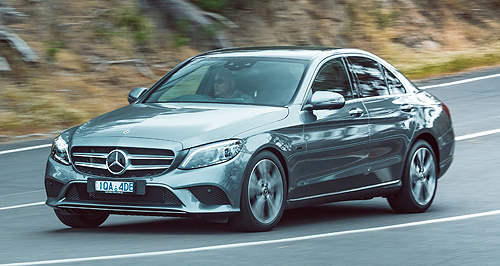New models - Mercedes-Benz - C-Class - C300eMercedes C300e arrives, but higher at $82,300Value equation still high for new Mercedes C-Class PHEV, despite currency pressures5 Jun 2020 MERCEDES-BENZ has increased the price of its freshly upgraded C-Class plug-in hybrid electric vehicle (PHEV) by $3100, to $82,300 plus on-road costs, since the new model was announced for the Australian market last September.
Originally set down at $79,200 plus on-roads, the C300e sedan is now $6400 more expensive than the C350e it replaces, but offsets the rise with nearly double the all-electric range, lower fuel consumption and substantially stronger performance.
The new C-Class PHEV is also more expensive than its direct rival, the BMW 330e PHEV, which kicks off from $78,900, though still manages to undercut the $84,990 Volvo S60 T8 PHEV.
According to Mercedes-Benz Cars Australia/Pacific head of media relations and public relations, Jerry Stamoulis, increasingly unfavourable exchange rates and higher costs meant the company had little choice but to revise the pricing for not only the C300e, but across the broader C-Class range.
While the C300e is manufactured in South Africa, much of its technology originates in Europe.
“Upward currency pressures meant we had no choice but to raise prices,” Mr Stamoulis told GoAuto. “The Australian dollar does not always move in the right direction.”
As GoAuto reported late last year, the C300e will not follow its C350e predecessor by offering a wagon alternative to match Volvo’s V60 T8 PHEV.
In a move mirrored by many other brands, an SUV – in this case the closely related GLC300e – is stepping in instead.
Launched last year, the mechanically near-identical, German-built GLC300e costs just $1200 more than the C300e sedan, at $83,500 plus on-roads.
“The GLC300e is offered for not much more money than what the C300e wagon would be, so given how much stronger SUV sales are, it makes much more sense to go with that,” Mr Stamoulis said.
“Unfortunately, there are fewer and fewer people who appreciate the merits of a great wagon nowadays. But from a business point of view, the move to an SUV hybrid makes much more sense.”
Mr Stamoulis added that the GLC300e’s larger and taller proportions provide more room for the hybrid technology and batteries, sidestepping the packaging compromise suffered by the electrified C-Class sedan, which at 300 litres for boot capacity loses 155L compared to combustion-engine versions.
In contrast, while the hybrid version of the medium SUV also loses 155L of cargo capacity compared to the regular 550L petrol-powered GLC300 equivalent, it still offers more space and practicality than the sedan.
As previously reported, the new C300e gains a 13.5kWh lithium-ion battery pack with up to 52km of electric-only driving range, compared to the 31km from the preceding C350e’s 6.2kWh pack.
Though powered by a similar 2.0-litre four-cylinder petrol engine producing 155kW of power and 350Nm of torque, driving the rear wheels via a nine-speed automatic transmission, the newcomer is also 0.3 litres per 100km more economical at 2.1L/100km.
It is also 30kW and 100Nm stronger with a total system output of 235kW/700Nm, which slashes the 0-100km/h acceleration time by half a second, to 5.4s.
Charging times are about seven hours using a Type 2 connector plugged into a domestic power outlet or two hours with an optional wallbox charger.
Additionally, electricity can be preserved on the go because the C300e’s high-voltage systems also power the air-conditioning and heater, meaning that the cabin temperature can be pre-conditioned while the car is still plugged in and being charged.
Plus, new predictive tech also saves energy by combining data from the satellite navigation, radar and cameras to optimise drivetrain energy usage and regenerative braking.
While the non-hybrid C300 is $8100 less expensive at $74,200 plus on-roads, its related 190kW/370Nm 2.0-litre four-cylinder turbocharged engine delivers less total power and torque (190kW/270Nm) than the combined outputs of the C300e, is half a second slower to 100km/h and uses 4.9L/100km more premium-unleaded petrol.
Among the high list of standard equipment on the C300e is air suspension, adaptive cruise control with predictive speed adjustment for corners, junctions and roundabouts, leather upholstery and keyless entry with push-button start including hands-free boot opening.
2020 Mercedes-Benz C-Class pricing*
*Excludes on-road costs  Quick testsRead more3rd of September 2019  Mercedes adds C300e plug-in hybridPlug-in hybrid C300e sedan joins Mercedes-Benz C-Class range, from $79,200 plus ORCs28th of September 2018  Driven: Mercedes takes C-Class to higher planeSignificant update set to reinvigorate all-important Mercedes C-Class rangeAll new models Alfa Romeo Alfa Romeo Abarth Abarth Audi Audi Aston Martin Aston Martin BMW BMW Bentley Bentley Chrysler Chrysler Chevrolet Chevrolet Dodge Dodge Citroen Citroen Ferrari Ferrari DS DS Ford Ford Fiat Fiat FPV FPV Foton Foton Haval Haval Great Wall Great Wall Honda Honda Holden Holden Hyundai Hyundai HSV HSV Isuzu Isuzu Infiniti Infiniti Jeep Jeep Jaguar Jaguar Lamborghini Lamborghini Kia Kia Lexus Lexus Land Rover Land Rover Mazda Mazda Maserati Maserati Mercedes-Benz Mercedes-Benz McLaren McLaren Mini Mini Nissan Nissan Mitsubishi Mitsubishi Peugeot Peugeot Opel Opel Proton Proton Porsche Porsche Renault Renault Ram Ram Saab Saab Rolls-Royce Rolls-Royce Smart Smart Skoda Skoda Subaru Subaru SsangYong SsangYong Tesla Tesla Suzuki Suzuki Toyota Toyota Volvo VolvoC-Class pricing
Motor industry news |
|

















Facebook Twitter Instagram